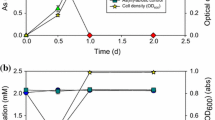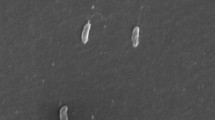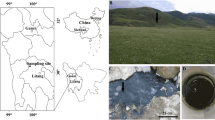Abstract
A new arsenite-oxidizing bacterium was isolated from a low arsenic-containing (8.8 mg kg−1) soil. Phylogenetic analysis based on 16S rRNA gene sequencing indicated that the strain was closely related to Stenotrophomonas panacihumi. Batch experiment results showed that the strain completely oxidized 500 μM of arsenite to arsenate within 12 h of incubation in a minimal salts medium. The optimum initial pH range for arsenite oxidation was 5–7. The strain was found to tolerate as high as 60 mM arsenite in culture media. The arsenite oxidase gene was amplified by PCR with degenerate primers. The deduced amino acid sequence showed the highest identity (69.1 %) with the molybdenum containing large subunit of arsenite oxidase derived from Bosea sp. Furthermore the amino acids involved in binding the substrate arsenite, were conserved with the arsenite oxidases of other arsenite oxidizing bacteria such as Alcaligenes feacalis and Herminnimonas arsenicoxydans. To our knowledge, this study constitutes the first report on arsenite oxidation using Stenotrophomonas sp. and the strain has great potential for application in arsenic remediation of contaminated water.





Similar content being viewed by others
References
Battaglia-Brunet F, Dictor M-C, Garrido F, Crouzet C, Morin D, Dekeyser K, Clarens M, Baranger P (2002) An arsenic(III)-oxidizing bacterial population: selection, characterization, and performance in reactors. J Appl Microbiol 93:656–667
Bhumbla DK, Keefer RF (1994) Arsenic mobilization and bioavailability in soils. In: Nriagu JO (ed) Arsenic in the environment. Part 1 Cycling and characterization. Wiley, New York, pp 51–82
Botes E, Heerden EV, Litthauer D (2007) Hyper-resistance to arsenic in bacteria isolated from an antimony mine in South Africa. S Afr J Sci 103:279–282
Cai L, Liu G, Rensing C, Wang G (2009) Genes involved in arsenic transformation and resistance associated with different levels of arsenic-contaminated soils. BMC Microbiol 9:4. doi:10.1186/1471-2180-9-4
Clifford D (1990) Ion exchange and inorganic adsorption. In: Pontius F (ed) Water quality and treatment, AWWA handbook. McGraw-Hill, New York, p 9
Dastidar A, Wang Y-T (2009) Arsenite oxidation by batch cultures of Thiomonas arsenivorans strainb6. J Environ Eng 135:708–715
Drewniak L, Styczek A, Sklodowska A (2007) Arsenic hypertolerant bacteria isolated from gold mine rocks biofilms. Adv Mater Res 20–21:576
Ellis PJ, Conrads T, Hille R, Kuhn P (2001) Crystal structure of the 100 kDa arsenite oxidase from Alcaligenes faecalis in two crystal forms at 1.64 and 2.03 Å. Structure 9:125–132
Garcia-Dominguez E, Mumford A, Rhine ED, Paschal A, Young LY (2009) Novel autotrophic arsenite-oxidizing bacteria isolated from soil and sediments. FEMS Microbiol Ecol 66:401–410
Gihring TM, Banfield JF (2001) Arsenite oxidation and arsenate respiration by a new Thermus isolate. FEMS Microbiol Lett 204:335–340
Green HH (1918) Description of a bacterium that oxidizes arsenite and one which reduces arsenate to arsenite from a cattle-dipping tank. S Afr J Sci 14:465–467
Ilyaletdinov AN, Abdrashitova SA (1981) Autotrophic oxidation of arsenic by a culture of Pseudomonas arsenitoxidans. Mikrobiologiya 50:197–204
Kinegam S, Yingprasertchai T, Tanasupawat S et al (2008) Isolation and characterization of arsenite-oxidizing bacteria from arsenic-contaminated soils in Thailand. World J Microbiol Biotechnol 24:3091–3096
Kumar S, Tamura K, Nei M (2004) MEGA3: Integrated software for molecular evolutionary genetics analysis and sequence alignment. Brief Bioinform 5:150–163
Lane DJ (1991) 16S/23S rRNA sequencing. In: Stackebrandt E, Goodfellow M (eds) Nucleic acid techniques in bacterial systematics. Wiley, Chichester, pp 115–175
Liao VH-C, Chu Y-J, Su Y-C et al (2011) Arsenite-oxidizing and arsenate-reducing bacteria associated with arsenic-rich groundwater in Taiwan. J Contam Hydrol 123:20–29
Mandal BK, Suzuki KT (2002) Arsenic round the world: a review. Talanta 58:201–235
Muller D, Lievremont D, Simeonova DD, Hubert J-C, Lett M-C (2003) Arsenite oxidase (aox) genes from a metal-resistant β-proteobacterium. J Bacteriol 185:135–141
Ng JC, Moore MR (2005) Arsenic in drinking water: a natural killer in Bangladesh and beyond. Med J Aust 183:562–563
Nriagu JO (2002) Arsenic poisoning through the ages. In: Frankenberger WT (ed) Environmental chemistry of arsenic. Marcel Dekker, New York, pp 1–26
Osborne FH, Ehrlich HL (1976) Oxidation of arsenite by a soil isolate of Alcaligenes. J Appl Bacteriol 41:295–305
Rhine ED, Phelps CD, Young LY (2006) Anaerobic arsenic oxidation by novel denitrifying isolates. Environ Microbiol 8:899–908
Rhine ED, Ní Chadhain SM, Zylstra GJ, Young LY (2007) The arsenite oxidase genes (aroAB) in novel chemoautotrophic arsenite oxidizers. Biochem Biophys Res Commun 354:662–667
Salmassi TM, Venkateswaren K, Satomi M, Newman DK, Hering JG (2002) Oxidation of arsenite by Agrobacterium albertimagni AOL15, sp. nov., isolated from hot creek, California. Geomicrobiol J 19:53–66
Santini JM, Sly LI, Schnagl RD, Macy JM (2000) A new chemolithoautotrophic arsenite-oxidizing bacterium isolated from a gold mine: phylogenetic, physiological, and preliminary biochemical studies. Appl Environ Microbiol 66:92–97
Sehlin HM, Lindström EB (1992) Oxidation and reduction of arsenic by Sulfolobus acidocaldarius strain BC. FEMS Microbiol Lett 93:87–92
Simeonova DD, Micheva K, Muller D et al (2005) Arsenite oxidation in batch reactors with alginate-immobilized ULPAs1 strain. Biotechnol Bioeng 91:441–446
Smedley PL, Kinniburgh DG (2002) A review of the source, behaviour and distribution of arsenic in natural waters. Appl Geochem 17:517–568
Suttigarn A, Wang Y-T (2005) Arsenite oxidation by Alcaligenes faecalis strain O1201. J Environ Eng 131:1293–1301
Turner AW (1949) Bacterial oxidation of arsenite. Nature (London) 164:76–77
US EPA (2000) Technologies and costs for removal of arsenic from drinking water, EPA report 815-R-00-028. US EPA, Washington DC
Weeger W, Lievremont D, Perret M et al (1999) Oxidation of arsenite to arsenate by a bacterium isolated from an aquatic environment. Biometals 12:141–149
WHO (1993) Guidelines for drinking water quality, vol 1: recommendations, 2nd edn. WHO, Geneva. http://www.who.int/water_sanitation_health/dwq/gdwq2v1/en/. Accessed 6 June 2012
Yoon I-H, Chang J-S, Lee J-H, Kim K-W (2009) Arsenite oxidation by Alcaligenes sp. strain RS-19 isolated from arsenic-contaminated mines in the Republic of Korea. Environ Geochem Health 31:109–117
Acknowledgments
This study was conducted while the first author was receiving the International Postgraduate Research Scholarship (IPRS) supported by the Australian Government in collaboration with the Centre for Environmental Risk Assessment and Remediation, University of South Australia. The authors would like to thank Dr. Mohammad Rahman for technical assistance with the ICP analysis and Dr. Kannan Krishnan for his assistance with the molecular study.
Author information
Authors and Affiliations
Corresponding author
Rights and permissions
About this article
Cite this article
Bahar, M.M., Megharaj, M. & Naidu, R. Arsenic bioremediation potential of a new arsenite-oxidizing bacterium Stenotrophomonas sp. MM-7 isolated from soil. Biodegradation 23, 803–812 (2012). https://doi.org/10.1007/s10532-012-9567-4
Received:
Accepted:
Published:
Issue Date:
DOI: https://doi.org/10.1007/s10532-012-9567-4




